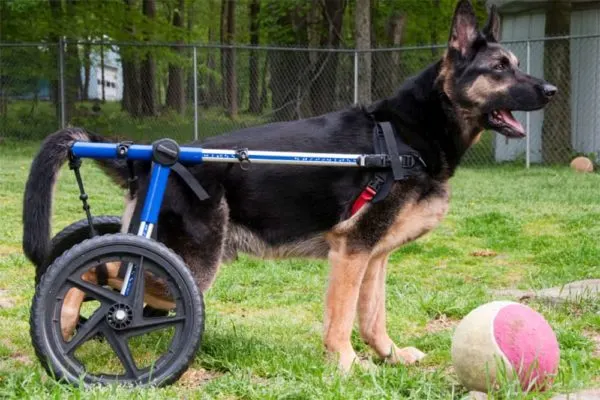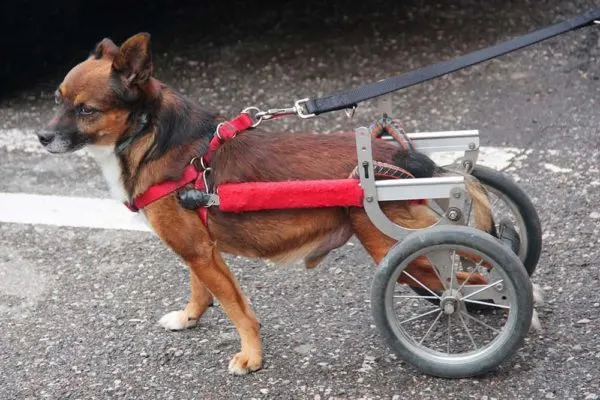The Ultimate Guide on Degenerative Myelopathy: When is the Right Time to Put Your Dog Down?
As a dog-owner, one of the things that you dread with every inch of your being, is the day that you find out that your dog is seriously ill.
Every dog-owner dreams of their dog passing away peacefully in their sleep, after living a full and happy life.
But sadly, just like humans, dogs are susceptible to serious illnesses that can bring a premature end to their life.
Degenerative myelopathy is just one of these serious illnesses that dogs can suffer with, and it is one of many diseases that can lead to owners having to make the difficult decision to put their dog to sleep.

What Is Degenerative Myelopathy? Everything You Need To Know
First, let’s take a look at exactly what degenerative myelopathy is. With medical conditions, you often face a lot of jargon, and this is the case with degenerative myelopathy.
So, let’s take a look at what it is, and how it affects your dog.
As its name suggests, degenerative myelopathy is a degenerative disease, in the same way that Alzheimer’s is a degenerative disease.
While Alzheimer’s affects the brain, degenerative myelopathy affects the spinal cord in dogs.
This disease causes the white matter in the spinal cord to break down, meaning that the spinal nerves begin to lose their ability to send signals.
As this happens, your dog’s ability to move around will gradually deteriorate.
Degenerative myelopathy is a heart-breaking condition for your dog to be diagnosed with, and ultimately it will be fatal.
While this condition is difficult and painful for you to watch as the owner, this isn’t a painful condition for your dog, and they will not suffer.
But, a lot of people choose to have their dog put to sleep, especially as they reach the later stages of this disease.
But how does degenerative myelopathy affect your dog? Let’s take a look at the symptoms of this condition.

Symptoms Of Degenerative Myelopathy (At Different Stages)
As is often the case with diseases, degenerative myelopathy is a condition that comes with different stages.
In the early stages, the symptoms of this condition are not severe, but as the condition worsens, they become more serious, and a lot more difficult to live with.
There are 3 stages of degenerative myelopathy; they are early, intermediate, and late. So, let’s take a look at the symptoms of this condition throughout these different stages.
Early Degenerative Myelopathy
In the early stages of this condition, your dog might experience just a handful of the following symptoms:
- Stumbling
- Tremors in the rear legs
- Toe Knuckling
- Poor coordination in the hind legs
- Loss of muscle in the hind legs
- Nail scraping
- Difficulty rising
- Wearing of inner digits on hind legs
- Hind end weakness causing difficulty walking upstairs and going for a walk.
Intermediate Degenerative Myelopathy
As the condition worsens, the symptoms that your dog experiences will begin to be more severe. They include:
- Double incontinence
- Limp tail that doesn’t wag
- Muscular atrophy
- Difficulty walking
- Difficulty rising
- Saggy rear end
- Loss of sensation in the hind legs
- Poor balance
Late Degenerative Myelopathy
Most vets will recommend euthanasia before your dog reaches this late stage of degenerative myelopathy, this is because the symptoms become extremely debilitating. They include:
- Total paralysis of the hind legs
- Jerky and uncontrollable movements in the hind legs and tail
- Respiratory issues
- Multiple organ failure
- Weakness in the shoulders and front legs
- Complete lost of balance and coordination
- The inability to stand/walk/support themselves without aid
At this stage, the condition has completely destroyed your dog’s quality of life, and a lot of people believe it is cruel to keep them alive.
This is why it is recommended that you put your dog to sleep before the condition progresses this far.

What Is The Cause For Degenerative Myelopathy?
There is no definitive cause for degenerative myelopathy, what causes this disease is still ultimately unknown. But, there are some things that have been linked with this condition. The main one being age.
This condition is primarily found in senior dogs, and most dogs reach the age of 8-10 before being diagnosed.
It is likely that the condition has been around for quite a while when it is diagnosed, and this is mainly because a lot of the symptoms can be dismissed as old age.
So, if your dog begins to display these symptoms, seek veterinary advice.
Another link to this disease, which has since been disproven, is breed. For a long time, it was thought that only German Shepherds suffered from this condition, it was even known as the ‘German Shepherd disease’.
But, in the years since then, it has become apparent that this condition can affect lots of breeds, from large breeds like the Bernese Mountain Dog, to smaller breeds such as the pug.
So, it seems that breed doesn’t matter when it comes to this condition.
When To Put Down A Dog With Degenerative Myelopathy
Finally, let’s discuss when is the right time to put your dog to sleep when they are suffering with this condition.
Ultimately, the decision is yours, and you should always seek advice from your veterinarian. But, let’s take a look at some facts surrounding this condition.
When a dog has been diagnosed with this condition, they will likely live for between 6 months and 3 years with this condition.
This, of course, depends on the stage of the condition when they were diagnosed, and the symptoms that they are experiencing. Your dog will be able to live with some early symptoms of this condition, but it is generally accepted that you should put your dog to sleep once their mobility stops.
Saying goodbye to your dog is one of the most difficult things you will experience as a dog-owner.
But, when their quality of life begins to suffer, there comes a time when you have to make this tough decision, and most vets will recommend euthanasia before your dog loses the ability to move around completely.
















